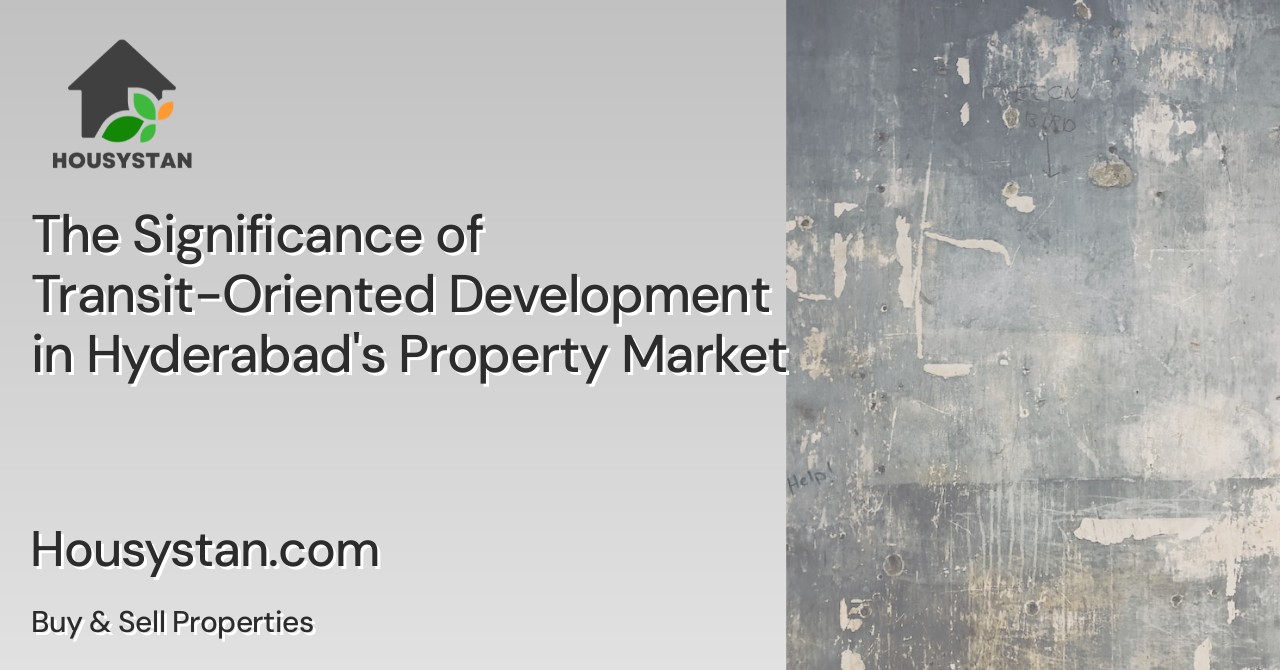The Significance of Transit-Oriented Development in Hyderabad's Property Market
Read latest blogs and articles from Housystan

The Information mentioned here was last updated on:
4/12/2025The Significance of Transit-Oriented Development in Hyderabad's Property Market
Understanding Transit-Oriented Development
In recent years, the term "transit-oriented development" (TOD) has gained significant traction in urban planning and property markets worldwide, including Hyderabad. At its core, TOD is an urban development approach that maximizes the amount of residential, business, and leisure space within walking distance of public transport hubs. This concept aims to create sustainable communities with reduced dependency on private vehicles, enhancing overall urban mobility and accessibility.
- Verified Tenants/Buyers
- Unlimited Property Listing
- Zero subscription/charges fee
Hyderabad’s Urban Growth and Challenges
Hyderabad, the capital of Telangana, has experienced rapid urbanization over the past few decades, spurred by economic growth and the expansion of its information technology sector. With this swift development, the city has faced challenges such as traffic congestion, pollution, and an overburdened infrastructure. As the population continues to increase, there is a pressing need to address urban sprawl and improve connectivity.
The Emergence of TOD in Hyderabad
In response to these challenges, Hyderabad has embraced the concept of transit-oriented development as a strategic solution. The city's government and urban planners have recognized the potential of TOD to alleviate traffic woes while stimulating economic activity. As a result, there has been a concerted effort to integrate development projects with public transport systems like the Hyderabad Metro Rail, bus rapid transit systems, and local trains.
Key Features of Transit-Oriented Development
Proximity to Public Transport
The hallmark of successful TOD is its proximity to public transport facilities. In Hyderabad, this is most evident around metro stations, where developments are designed to ensure easy access to transit services. This strategic placement encourages the use of public transport for daily commutes, reducing the reliance on personal vehicles.
Mixed-Use Development
Another defining feature of TOD is the integration of mixed-use developments. This means that residential, commercial, and recreational spaces are all clustered together, fostering vibrant communities. In Hyderabad, areas near transit hubs are seeing a rise in high-rise apartments, shopping centers, and office spaces, allowing residents to live, work, and play within a single neighborhood.
Pedestrian-Friendly Infrastructure
TOD places a strong emphasis on pedestrian-friendly infrastructure. This includes well-maintained sidewalks, safe crosswalks, and shaded walkways to encourage walking. In Hyderabad, efforts are being made to improve pathways and create green spaces around transit points, enhancing the quality of life for residents and promoting healthier lifestyles.
Economic Impacts of TOD in Hyderabad
Boosting Property Values
One of the most tangible impacts of transit-oriented development in Hyderabad is the boost in property values. Properties located near transit hubs are often in high demand, as they offer convenient access to transportation and amenities. This demand drives up real estate prices, providing lucrative opportunities for investors and developers.
Stimulating Local Economies
TOD developments contribute to local economic growth by attracting businesses and consumers to concentrated areas. The influx of people using transit systems supports retail outlets, restaurants, and service providers, creating new job opportunities and revitalizing local economies.
Reducing Infrastructure Costs
By concentrating development around transit hubs, TOD reduces the need for extensive road networks and parking facilities. This efficient use of space can lower urban infrastructure costs, allowing the city to allocate resources more effectively towards other essential services.
Environmental Benefits of TOD
Lowering Carbon Emissions
In cities like Hyderabad, where traffic congestion and vehicle emissions are significant issues, TOD offers a pathway to a more sustainable future. By promoting the use of public transportation and reducing dependency on cars, TOD helps lower carbon emissions, contributing to cleaner air and a healthier environment.
Land Use Optimization
Furthermore, TOD promotes efficient land use by reducing urban sprawl. By building vertically rather than horizontally and integrating multiple functions within a single area, TOD helps preserve green spaces and agricultural land on the city's outskirts.
Social Implications of TOD in Hyderabad
Improved Accessibility and Inclusivity
Transit-oriented development can enhance accessibility for all social groups, including those without access to private vehicles. By prioritizing public transportation, TOD bridges the gap between different socio-economic classes, providing everyone with equal opportunities to access jobs, education, and leisure activities.
Enhancing Community Connection
The concentrated nature of TOD facilitates social interaction and community building. Shared spaces, such as parks and recreational facilities near transit hubs, encourage residents to engage with one another, fostering a sense of community and belonging.
Challenges and Considerations for TOD in Hyderabad
Managing Urban Density
While TOD offers numerous benefits, it also comes with challenges. One such challenge is managing the increased urban density around transit hubs. It is crucial to ensure that infrastructure development keeps pace with population growth to avoid overcrowding and the strain on public services.
Ensuring Affordability
Another concern is maintaining affordability. As property values rise near transit hubs, there is a risk of displacing lower-income residents. Urban planners must strike a balance between development and affordability, perhaps by incorporating affordable housing into TOD projects.
Integrating Multiple Stakeholders
Successfully implementing TOD requires collaboration between various stakeholders, including government agencies, private developers, and the community. Coordinated efforts are necessary to ensure that development aligns with public needs and long-term urban planning goals.
Conclusion: The Ongoing Journey of TOD in Hyderabad
In Hyderabad, transit-oriented development is more than just a trend—it's a strategic approach to shaping the city's future. By prioritizing public transportation and optimizing land use, TOD addresses urban challenges while paving the way for sustainable growth. As Hyderabad continues to evolve, the principles of TOD will likely play an integral role in redefining its urban landscape, fostering a more connected, accessible, and economically vibrant city. As stakeholders continue to refine and implement TOD strategies, Hyderabad can look forward to reaping the benefits of these thoughtful, people-centric developments.